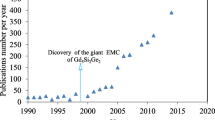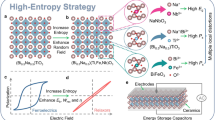Abstract
IT has recently been reported that the remanent magnetization of hæmatite (αFe2O3) indicates a marked thermal hysteresis phenomenon during a cooling–heating cycle to interpose the transition temperature of about 250° K., where the rotation of spin axis occurs: on cooling below 250° K. and then re-heating to room temperature, the direction of the remanent magnetization is still memorized in the specimen, although its intensity does not recover its original value before the cooling–heating cycle1. A satisfactory explanation of such behaviour has not so far been given, though much work has been carried out on this problem2,3. In this communication, new information on the ‘memory’ phenomenon will be reported.
Similar content being viewed by others
References
Haigh, G., Phil. Mag., 2, 505, 877 (1957).
Lin, S. T., J. App. Phys., 31, 273S (1960).
Siratori, K., Tasaki, A., and Iida, S., J. Phys. Soc. Japan, 15, 2357 (1960).
Author information
Authors and Affiliations
Rights and permissions
About this article
Cite this article
NAGATA, T., YAMA-AI, M. & AKIMOTO, S. ‘Memory’ of Initial Remanent Magnetization and Number of Repeating of Heat Treatments in Low-temperature Behaviour of Hæmatite. Nature 190, 620–621 (1961). https://doi.org/10.1038/190620a0
Issue Date:
DOI: https://doi.org/10.1038/190620a0
- Springer Nature Limited





